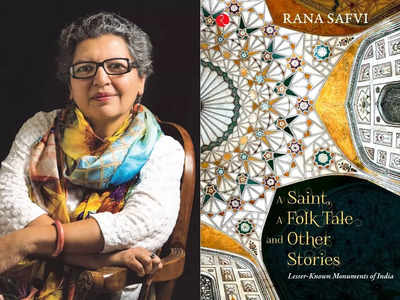- News
- lifestyle
- books
- interviews
- Exclusive interview: Author Rana Safvi on her latest book, role of monuments in history, and more
Trending
This story is from January 17, 2022
Exclusive interview: Author Rana Safvi on her latest book, role of monuments in history, and more
In a recent conversation with TOI Books, Safvi talked in detail about her latest book, the role of monuments in history, and more.

Pic credit: Rupa Publications
Author and translator Rana Safvi's latest book titled 'A Saint, A Folk Tale and Other Stories' hit the stands in December 2021, and has received much critical acclaim since then. Published by Rupa Publications, the book "takes the reader into secret, hidden parts of India beyond the usual tourist destinations." It takes you back in time and on a journey to explore the vast architectural heritage of India.
The book's blurb reads: "Discover the secrets that Khusrau Bagh hides in its heart, marvel at a Queen’s forgotten resting place, listen to the folk tales and fables embedded in the structures and walk down the poetic path to some of the places where the great poets sleep, with the hope that the book sets the reader off on a journey of their own."
In a recent conversation with TOI Books, Safvi talked in detail about 'A Saint, A Folk Tale and Other Stories', the role of monuments in history, why some monuments are more popular than others, and more.
1. Your last few books focus extensively on the city of Delhi, its history, and its forgotten monuments. However, in your latest book 'A Saint, A Folk Tale And Other Stories', you move away from Delhi and talk about the "lesser-known" monuments of India. Why the shift?
2. Why do you feel the need to write about monuments that are lesser-known or forgotten? What role do monuments play in our history?
While the famous monuments see huge tourist footfall, there are equally important parts of our built heritage that are neglected. This neglect is often related to neglect of the monument too. My objective was to raise awareness and create a connection in the minds of travelers which would make invoke a desire in them to visit it. Monuments are tangible forms of art and it's the most common way to engage with history particularly for students and those from streams other than liberal arts and a wonderful way to learn about the history of that period.
3. A monument is a monument- a piece of history. Then why do some of them are extremely popular and others in dire need of restoration?
The popularity of a monument depends on the way it is written about and perceived as part of our collective memory. Taj Mahal is indeed one of the most magnificent specimens of architecture and has been written about by innumerable people. The story of the Taj Mahal as a monument of love is stamped in our minds and thus it’s not surprising that it is the most visited monument in India. But what of Burhanpur? Mumtaz Mahal died there and was given temporary internment in the Ahookhana there. Her body was brought to Agra for permanent burial six months later. That city is full of Mughal relics, memories of Abdur Rahim Khan-e Khana who served as a subedar there, and of Mumtaz Mahal. I hope my stories help in developing a tourist footfall there which will result in the upkeep and preservation of these monuments.
4. At a time when names of several places, cities, and monuments are being changed, do you feel a difference in the way authorities and people approach a monument in terms of religion? Is there something as a "Hindu monument" or "Muslim monument"?
My whole purpose of writing about our built heritage is to remove this us vs them debate. Our built heritage belongs to all and deserves the care and attention of all. For me, every piece of our architectural legacy showcases the skill and devotion of our Indian artisan, craftsmen, and architects. It is that which we have to celebrate. My book is dedicated to the artisans who gave their lives to leaving behind monuments for posterity with a verse by Sahir Ludhianvi from his nazm 'Taj Mahal':
“Meri mahbub unhen bhi to mohabbat hogi
Jin ki sannai ne bakhshi hai use shakl-e-jamil
Un ke pyaron ke maqabir rahe benam-o-numud
Aaj tak un pe jalai na kisi ne qindil”
—Sahir Ludhianvi
(My love, they must have also loved
They, whose artistry bestowed it this beautiful shape
The tombs of their loved ones, remain forgotten
Till now no one has even lit a candle to their memory)
5. According to you, which is the best, yet the most underrated monument in Delhi and India? Why?
If we talk of pan-India then my favorite is the Fatehpur Sikri. It pales in comparison to the Taj Mahal and most visitors to Agra do not make the trip to Fatehpur Sikri. It is a testament to our glorious and syncretic history. In Delhi, my favorite haunt is Mehrauli Archaeological Park with a history that stretches from the Delhi Sultans to Mughals. We see the appearance of the first true arch in Balban’s tomb and the glory of a magnificent multi-colored incised plaster ceiling in Maulana Jamali’s tomb.
6. Five books that you recommend for those who want to know about the monuments of India?
As far as monuments of India are concerned I have relied on Archaeological Survey reports through the years starting from the 19th century, Percy Brown’s 'Indian Architecture', Upinder Singh and Nayanjot Lahiri’s 'Ancient India: New Research', Catherine Asher’s 'Architecture of Mughal India', Ebba Koch’s 'Mughal Architecture: An Outline of its History and Development (1526–1858)' and Naman Ahuja’s 'Art and Archaeology of Ancient India: Earliest Times to the Sixth Century'. Apart from this, there are detailed descriptions available on different individual monuments and sites.
7. Five lesser-known monuments in India you think everyone should visit?
All the monuments of Burhanpur but in particular the Ahookhana where Mumtaz Mahal was given temporary burial before her body was brought to Agra to be interred in the Taj Mahal, Barabar Caves in Bihar, Bhitargaon Temple near Kanpur, the baolis and tombs in Chanderi, and the monuments in Gaur and Pandua in West Bengal.
The book's blurb reads: "Discover the secrets that Khusrau Bagh hides in its heart, marvel at a Queen’s forgotten resting place, listen to the folk tales and fables embedded in the structures and walk down the poetic path to some of the places where the great poets sleep, with the hope that the book sets the reader off on a journey of their own."
In a recent conversation with TOI Books, Safvi talked in detail about 'A Saint, A Folk Tale and Other Stories', the role of monuments in history, why some monuments are more popular than others, and more.
1. Your last few books focus extensively on the city of Delhi, its history, and its forgotten monuments. However, in your latest book 'A Saint, A Folk Tale And Other Stories', you move away from Delhi and talk about the "lesser-known" monuments of India. Why the shift?
I have described over 450 monuments of Delhi in my Delhi Trilogy and though a few are still unaccounted for, I have covered almost all major monuments in Delhi. There is a dire need to raise awareness about our built heritage and thus I felt the need to cast my net wider and describe lesser-known monuments of India.
2. Why do you feel the need to write about monuments that are lesser-known or forgotten? What role do monuments play in our history?
While the famous monuments see huge tourist footfall, there are equally important parts of our built heritage that are neglected. This neglect is often related to neglect of the monument too. My objective was to raise awareness and create a connection in the minds of travelers which would make invoke a desire in them to visit it. Monuments are tangible forms of art and it's the most common way to engage with history particularly for students and those from streams other than liberal arts and a wonderful way to learn about the history of that period.
3. A monument is a monument- a piece of history. Then why do some of them are extremely popular and others in dire need of restoration?
The popularity of a monument depends on the way it is written about and perceived as part of our collective memory. Taj Mahal is indeed one of the most magnificent specimens of architecture and has been written about by innumerable people. The story of the Taj Mahal as a monument of love is stamped in our minds and thus it’s not surprising that it is the most visited monument in India. But what of Burhanpur? Mumtaz Mahal died there and was given temporary internment in the Ahookhana there. Her body was brought to Agra for permanent burial six months later. That city is full of Mughal relics, memories of Abdur Rahim Khan-e Khana who served as a subedar there, and of Mumtaz Mahal. I hope my stories help in developing a tourist footfall there which will result in the upkeep and preservation of these monuments.
4. At a time when names of several places, cities, and monuments are being changed, do you feel a difference in the way authorities and people approach a monument in terms of religion? Is there something as a "Hindu monument" or "Muslim monument"?
My whole purpose of writing about our built heritage is to remove this us vs them debate. Our built heritage belongs to all and deserves the care and attention of all. For me, every piece of our architectural legacy showcases the skill and devotion of our Indian artisan, craftsmen, and architects. It is that which we have to celebrate. My book is dedicated to the artisans who gave their lives to leaving behind monuments for posterity with a verse by Sahir Ludhianvi from his nazm 'Taj Mahal':
“Meri mahbub unhen bhi to mohabbat hogi
Jin ki sannai ne bakhshi hai use shakl-e-jamil
Un ke pyaron ke maqabir rahe benam-o-numud
Aaj tak un pe jalai na kisi ne qindil”
—Sahir Ludhianvi
(My love, they must have also loved
They, whose artistry bestowed it this beautiful shape
The tombs of their loved ones, remain forgotten
Till now no one has even lit a candle to their memory)
5. According to you, which is the best, yet the most underrated monument in Delhi and India? Why?
If we talk of pan-India then my favorite is the Fatehpur Sikri. It pales in comparison to the Taj Mahal and most visitors to Agra do not make the trip to Fatehpur Sikri. It is a testament to our glorious and syncretic history. In Delhi, my favorite haunt is Mehrauli Archaeological Park with a history that stretches from the Delhi Sultans to Mughals. We see the appearance of the first true arch in Balban’s tomb and the glory of a magnificent multi-colored incised plaster ceiling in Maulana Jamali’s tomb.
6. Five books that you recommend for those who want to know about the monuments of India?
As far as monuments of India are concerned I have relied on Archaeological Survey reports through the years starting from the 19th century, Percy Brown’s 'Indian Architecture', Upinder Singh and Nayanjot Lahiri’s 'Ancient India: New Research', Catherine Asher’s 'Architecture of Mughal India', Ebba Koch’s 'Mughal Architecture: An Outline of its History and Development (1526–1858)' and Naman Ahuja’s 'Art and Archaeology of Ancient India: Earliest Times to the Sixth Century'. Apart from this, there are detailed descriptions available on different individual monuments and sites.
7. Five lesser-known monuments in India you think everyone should visit?
All the monuments of Burhanpur but in particular the Ahookhana where Mumtaz Mahal was given temporary burial before her body was brought to Agra to be interred in the Taj Mahal, Barabar Caves in Bihar, Bhitargaon Temple near Kanpur, the baolis and tombs in Chanderi, and the monuments in Gaur and Pandua in West Bengal.
End of Article
FOLLOW US ON SOCIAL MEDIA









